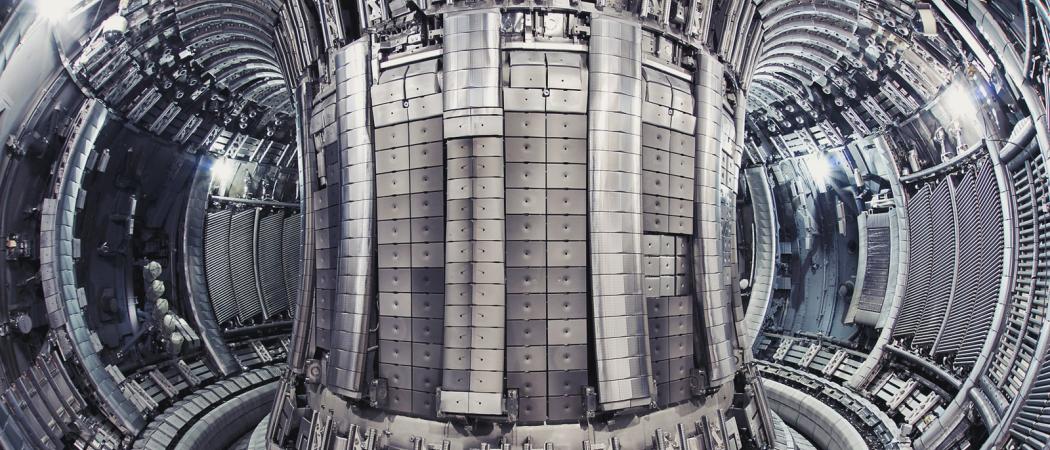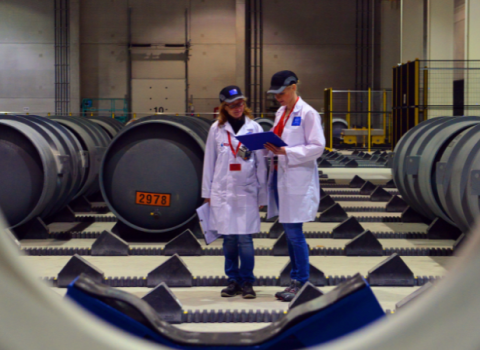Brexit has disrupted life at the biggest fusion facility in the world. But as it enters the final stage of its operation, JET is ‘out to smash records’, Ian Chapman, CEO of nuclear fusion programme tells Science|Business

The tokamak design of the fusion research facility in Culham.
The Joint European Torus (JET), a mammoth science project pursuing the long held dream of a virtually unlimited source of power, is entering what will likely be its final act.
Located some 50 miles west of London, in Culham, the nuclear fusion facility, one of the world’s biggest and most expensive science experiments, is helping determine the design of the power plants of the future, before handing the task over to ITER, the experimental fusion reactor being built in southern France, in 2025.
The road to harnessing nuclear fusion as a boundless source of energy is long and winding. Project deadlines have been postponed many times. Brexit is the latest in a series of obstacles.
The JET facility, which has annual funding of nearly €60 million from the European Commission, is currently operating under a temporary extension to its contract which will expire on March 28, the day before the UK is due to leave the EU. The extension was agreed after JET’s funding contract with the Commission ran out at the end of 2018.
The EU wants to extend the contract to the end of 2020, but talks are stalled pending a Brexit outcome. “We’re uncomfortably close to the end of the Brexit process,” says Ian Chapman, CEO of the UK Atomic Energy Authority. “But there are different ways to achieve the desired outcome.”
“There’s an existential question until contracts are signed, there’s risks. But we’re busy preparing for all eventualities with a quiet confidence that we’ll find a solution. We have agreed no-deal plans with European Commission and the UK government,” said Chapman. He was appointed in 2016, then aged 34, placing him among the youngest CEOs of a major research centre in the world.
A sense of uncertainty is not new to the facility, the key testing ground for ITER, because it’s always been that way for fusion, one of the world’s most controversial and doubted science fields. “JET’s had a one-year lifetime for 30 years,” Chapman told Science|Business.
But Brexit has been the latest major distraction to the job at hand: hitting the next milestone on the painstaking and expensive path to a new source of energy.
The eventual goal for fusion, the atomic reaction that takes place in the sun and in hydrogen bombs, is that it can be harnessed on-demand, to generate power.
JET has been slowly advancing the science on this almost too-good-to-be-true energy source. The facility, which opened in 1984, ran the world's first experiment using two forms of hydrogen, deuterium and tritium, in 1991.
It then ran the most successful fusion attempt ever, in 1997, creating 16 mega-watts (MW) of power – a return of 60 per cent on the energy fed in.
The energy, which lasted for mere hundreds of a second, could very briefly power the nearby town of Abington (population 36,000). So far, no fusion experiment has been able to get more energy out of a reaction than was put in. JET’s record 16MW pulse needed 24MW to make it happen.
In a future fusion power plant, the heat would be used to make steam to turn a turbine to generate electricity.
Over the next few years before handing the baton to ITER, JET is aiming for the coveted goal of break even, where fusion yields as much energy as it consumes. “I think we can do better than we did in 1997. I’m hoping we can smash our record,” said Chapman.
Smashing it would mean sustaining fusion power for up to five seconds.
The complex cappuccino maker
Splitting atoms – nuclear fission – can take place at room temperature, but to get fusion, two main ingredients, deuterium and tritium, are lashed with extreme heat until they jam together to form helium, unleashing tremendous energy.
When the JET machine is running at full tilt, it is the hottest place in the solar system – 10 times hotter than the core of the sun. The record temperature recorded at JET is 300 million degrees Celsius.
The sweet spot for fusion is between 150-200 million degrees Celsius. Too hot and the ingredients will not fuse.
How is it possible to hold and contain anything this hot? The best answer to date is a doughnut-shaped chamber called the tokamak. This is where the fusion reactions take place, within hot plasma containing deuterium and tritium atoms.
The moment of fusion has been so fleeting up to now because the tokamak struggles to trap heat; it quickly radiates out.
The JET tokamak, hidden beneath an enormously complex swarm of cables and some 150 diagnostic tools, sits in a room the size of an aircraft hangar, protected by immense slabs of concrete.
When it runs, the machine resembles something like a giant cappuccino maker, with attached arms forcing energy into the centre, warming it with pressure.
The JET machine has not been fed tritium since the record-breaking attempt in 1997 because more use of radioactive tritium will mean higher clean-up costs when JET is eventually decommissioned (deuterium by comparison is more benign).
Although EU funds pay for JET, the UK has sole liability for its eventual clean-up, which will be small compared with conventional nuclear reactors. Radiation from fusion is not nearly as long-lived as the spent fuel rods and irradiated components of a fission reactor.
A new run of deuterium-tritium experiments planned to take place at JET in the next few years will provide a dress rehearsal for experiments at ITER’s stadium-sized tokamak. ITER, in turn, will pave the way for another project called Demo, one or more proof-of-concept fusion power stations.
Frustrations
The frustrations of fusion are obvious, but the potential prize is an invaluable contribution to reducing planet-warming emissions. Fusion reactions release no carbon dioxide. Their fuel, derived from water, is abundant.
“There’s a lot of expectation, but we put it on ourselves. We want to see it achieved more than anyone else,” Chapman said.
“There are frustrations with how long the process has taken and you constantly need to convince stakeholders to keep investing. You have to show a path to impact and I think we’re doing an increasingly good job at that.”
A typical day at JET sees scientists milling around computer monitors, analysing experiments.
Scientists come to Culham from countries including Portugal, Hungary and Croatia. On a busy day, the tokamak can run between 40 and 50 experiments. UK scientists get around 10-15 per cent of the time on JET.
The engineers are in another room, playing with remotely operated arms.
They practice manoeuvres on a mock-up tokamak, hoping to optimise their routines. Any problems have to be found and snuffed out quickly, before they wreak havoc down the road.
These remote control capabilities are part of a range of hi-tech activities spinning out of JET, encompassing robotic maintenance, materials testing and fuel handling. The skills acquired at JET have enabled UK industry to win multi-million-euro contracts from ITER.
Staff turnover at JET is generally small, but Brexit has made it harder to recruit.
“Attracting new people, in the absence of very clear statements [about the future], is an increasingly hard sell. People are more nervous about it,” Chapman said.
The attrition rate is up from less than 5 per cent to just above 10 per cent. “It’s not a crazy level for many sectors, and we are still able to recruit good people. And a number of the people who have left have ended up in ITER – this is part of our role, after all, to develop the future fusion researchers,” Chapman says.
The way to ITER
ITER meanwhile promises to produce net fusion power sometime after 2035, if the present schedule holds.
The partners in the byzantine structure – the EU, Japan, China, Russia, the US, India and South Korea – have agreed to contribute pieces of the reactor, with the central ITER organisation responsible for coordinating construction. The EU owns 45 per cent of the project and the other partners nine per cent each.
Participating countries sometimes complain that the project consumes too much research budget.
Originally foreseen to switch on in 2016 and cost around €5 billion, the price of the ITER reactor has since roughly quadrupled and its start date been pushed back to 2025. If it comes together, full-scale experiments are foreseen in 2035.
The US has historically been the biggest ITER doubter. The country left the project for five years at the turn of the century.
It is, says Chapman, “the most scrutinised science programme ever.” The project is extremely challenging but, “the last three years have been very good; the vast majority of milestones have been met. Chapman visits the site every eight weeks. “You can see ostensible change every time,” he says.
ITER’s current good run is down to a “really excellent DG (director-general) who is used to building big nuclear things,” Chapman says. Bernard Bigot, the ITER director-general, previously ran France’s atomic energy agency. Before his appointment, the feeling was that the project was in danger of veering off course.
Chapman points out that while countries once guarded their fusion plans out of suspicion, now the only option they see is to share everything.
“Fusion was this funny sector where everything was done in silos until after the war – but now it has gone from being the least collaborative science field to the most. In that sense, it’s an inspiring environment to work in,” Chapman said.





 A unique international forum for public research organisations and companies to connect their external engagement with strategic interests around their R&D system.
A unique international forum for public research organisations and companies to connect their external engagement with strategic interests around their R&D system.